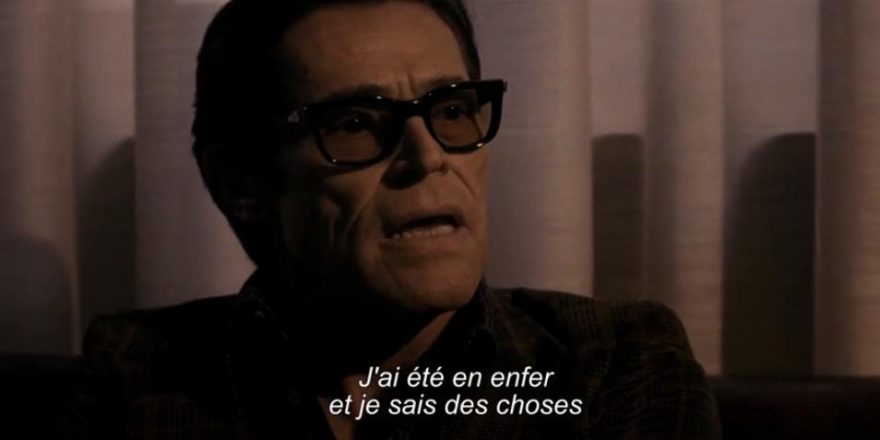Christopher Nolan’s Interstellar raises a lot of questions about philosophical, moral and scientific issues, but it also poses a more concrete question that applies to the act of filmgoing itself: what is the best exhibition format in which to view a movie? Although digital projection in the form of DCPs is now ubiquitous outside of museums and revival houses, there’s a small but passionate movement among filmmakers like Nolan, Paul Thomas Anderson and Quentin Tarantino to preserve film not only as a capture medium but also as the ideal way to see movies projected. Anderson famously released The Master in 70mm a couple of years ago, Tarantino just announced that his upcoming The Hateful Eight will strike 70mm prints as well, and Nolan gave theaters willing to show Interstellar on one of three celluloid formats (70mm, 70mm IMAX or 35mm) the opportunity to play the picture two days early.
Because Anderson, Nolan and Tarantino are three of the best directors we have (the three best of their generation, in my opinion), their proclamations about the superiority of celluloid carry a lot of weight with film students, other filmmakers and the press. Under ideal circumstances, I agree with them that light projected through celluloid is the best way to view a movie. I also think that those ideal circumstances are virtually nonexistent. When I was in film school in the early 1990s and 35mm was still the norm, I would say that seven out of 10 movies I went to had some kind of projection problem: either the focus was soft, or the picture was out of frame, or the projectionist forgot to flip on the stereo. Plus, if you didn’t see a movie opening weekend, forget about a pristine print — most of the time those things looked like somebody had been shaving with them by the fifth or sixth day of their release.
Nowadays, the majority of 35mm presentations are at revival houses, where 80 percent of the prints have lost most or all of their color and look like they’ve been rubbed against a cheese grater. If the idea behind theatrical exhibition is to give the audience an experience as close as possible to what the filmmakers intended, the notion that 35mm is inherently superior to digital is highly debatable. A DCP does not lose its color. It doesn’t get scratched. It’s never out of focus or out of frame. So is a deteriorated print of, say, William Friedkin’s Sorcerer that has faded to pink and is missing frames really a more faithful reproduction of his work than the gorgeous DCP that he recently supervised? Having seen that movie projected both ways, I have to say that if you can answer yes to that question you need to have your eyes examined.
Of course, I’ve found that many of the most insistent purists when it comes to 35mm presentation have one thing in common: they barely ever go to the movies. They might watch films at premieres, or in private screening rooms, or on studio lots, or at press screenings, or on DVD screeners, but they don’t pay money to walk into an AMC or a Regal and see how 99.9 percent of the world is experiencing cinema. If they did, they would get down on their knees and thank God for the day DCPs were invented, because it’s pretty much the only way you can see a movie in focus in a commercial theatre. That said, I’ll be the first person to admit that a lot of the people who make the case for film over digital are smarter than me, so when I found out that Interstellar was being released in six different formats — three film and three digital — I saw an opportunity for an experiment. I would go see Nolan’s movie every day of its opening week — six times in six days in six different theaters in six different formats, the idea being that if there was ever a way to chart the differences between film and digital, this would be it.
Interstellar was released in 70mm, 70mm IMAX, digital IMAX, 35mm, 4K DCP and 2K DCP, and I sat through it from beginning to end in all six ways it was possible to see it. I started off on opening day with 35mm, and to give the 35mm Interstellar the fairest possible shake, I went to see it at the New Beverly Cinema, the theater owned by Quentin Tarantino himself. As noted, Tarantino is a celluloid fundamentalist, a guy who recently proclaimed that, “compared to film, digital projection is like coming to a gunfight with a knife.” When he took over programming at the New Beverly this October he announced that nothing would ever be shown there in a digital format — it’ll be 35mm all the time, with some 16mm prints thrown in on occasion.
I love what Tarantino has done at the New Beverly — I’m there no fewer than three times a week, because his programming is exceptional. He regularly shows films, like the James Garner car flick The Racing Scene and George C. Scott’s off-the-wall indie The Savage is Loose, that are virtually impossible to see anywhere else, and he has a way of matching up films in double or triple features that make the whole program greater than the sum of its parts. The prints are often scratchy and the color faded, but I’ll buy Tarantino’s argument that that’s part of the experience — these are movies that have been watched and loved for years, and I suppose there’s a slight sense of nostalgia that comes with seeing the splices and cue marks. Where Tarantino loses me is in his absolutism — his constant declarations that imply that any print is better than any digital projection. I love that Tarantino has a theater that only shows 35mm — it’s a great resource to have, just like the other theaters in Los Angeles (the Egyptian, Aero, etc.) that show pristine DCPs of classic films. But his blanket statement that film is always better than digital is not entirely supportable — especially given the 35mm presentation of Interstellar in his own theatre.
The movie looked and sounded terrific there — for about 18 minutes. Then came the reel change, and the picture suddenly slipped slightly out of frame, meaning that every time there was a cut, a distracting splice line from the negative would appear at the top of the screen. To make matters worse, the focus went slightly soft at the reel change. I complained about both of these issues a couple of times to theatre staff, then gave up when nothing changed — meaning that I and everyone else in the theatre watched about half of Interstellar out of focus and out of frame, since every other reel was screwed up. The next day, someone (not me) criticized the projection on the New Beverly’s Facebook page, and the theatre responded with a comment that a theatre employee was in the theater and thought everything looked fine. This brings me back to my point about “ideal circumstances” — how can they possibly exist when even the people who work in the theatre have no idea how an anamorphic 35mm print is supposed to be projected?
I left the New Bev thinking maybe I’d have better luck with 70mm, since at least in 70mm there’s only one lens for the projectionist to focus, as opposed to the two used in anamorphic 35mm. Unfortunately, that was still one lens too many for the geniuses at the Cinerama Dome, where the standard 70mm presentation was marred by an odd black shadow that flickered on and off at the right side of the frame for the entire movie. There also seemed to be slight registration problems that gave the image an occasional jitter, though nothing too disastrous — indeed, celluloid purists often refer to this kind of jitter as something that gives film a warmer, less antiseptic and “perfect” quality than the rock-steady stability of DCPs. Personally, I’m not sure why perfect is a bad thing, especially when I’ve shelled out almost 20 bucks to go to a movie.
Which brings me to IMAX. Most of the time, I think of this format as the biggest racket going, a scam designed to jack up ticket prices for uninformed suckers. The only significant difference between an IMAX screen and a normal one is the height; IMAX screens have a boxier aspect ratio than the standard 1.85:1 or 2.35:1 formats, and the idea, I guess, is that you’re going to feel more immersed in the image when it reaches from the floor to the ceiling. The problem is that since virtually no Hollywood narrative films are actually shot in the IMAX aspect ratio, that floor-to-ceiling space is never fully used. If you go see a movie like The Equalizer on an IMAX screen, there are black bars at the top and bottom of the frame, making the image you’re paying extra for smaller. The most egregious demonstration of this is the legendary Chinese Theatre in Hollywood, which converted to IMAX a year or so ago. Now any movie shot in the 2.35:1 ’Scope aspect ratio is tinier than it was before the overhaul, but the ticket prices have nearly doubled.
Interstellar is one of the rare exceptions to the rule that IMAX is a rip-off — sort of. Nolan shot some (but nowhere near all) of the movie with actual IMAX 70mm cameras in their 1.43:1 aspect ratio, and the rest in 35mm anamorphic. That means that when you watch the film in 70mm IMAX at a place like the Chinese, as I did, the image alternates between shots that fill the entire screen and shots that are letterboxed with significant sections of black space at the top and bottom of the frame. The constantly shifting aspect ratios were extremely distracting to me at first, but once I got over it I have to admit that the 70mm IMAX presentation was phenomenal — razor-sharp clarity, vivid color reproduction and subtleties of contrast that blew away most of the other formats in which I saw the film… except for digital IMAX, which was nearly as good. In fact, I could barely tell the difference between the 70mm IMAX presentation and the digital IMAX, aside from the odd fact that the digital IMAX screen wasn’t quite as tall — meaning the image was slightly cropped at the top and bottom during the full-frame IMAX shots.
Of course, from what I can gather, all of the scenes filmed in IMAX are cropped for the standard 35mm and 70mm prints and DCPs, all of which are in the 2.35:1 aspect ratio. Which I find really strange. To my mind, there’s only one perfect composition for any given shot, so is Nolan compromising a third of his movie for 90 percent of the people who will see it? I know he’s smarter than I’ll ever be (after six viewings of his film, I still don’t completely understand how the science works), but this seems like a weird way to make movies. Regardless, fluctuating aspect ratios aside, both IMAX presentations of Interstellar were fantastic moviegoing experiences — at this top level of exhibition, film vs. digital was basically a draw.
Which left the standard 2K and 4K DCPs, formats that essentially had to compete with the standard 35mm and 70mm prints for my experiment, since all shared a common aspect ratio. I watched a 4K DCP at a run-of-the-mill suburban multiplex, and in terms of contrast and color it seemed to have slightly less texture than the film prints — it looked kind of like new TVs do when they come pre-adjusted to that “Vivid” setting. What it lacked in contrast and color, however, it made up for merely by being in focus and stable, something I can’t say for either of the non-IMAX celluloid presentations I saw. Surprisingly, the 2K presentation I saw at a different theatre was vastly superior; it looked identical to the two IMAX presentations in terms of the tonal range of the image, and was probably the most I enjoyed the movie anywhere, since I didn’t have the distraction of those constantly shifting aspect ratios throwing me out of the movie. Still, in the end I guess I have to give IMAX the edge since it’s the most faithful rendering of the director’s intentions.
I know that saying the 2K Interstellar was better than the 4K version seems counterintuitive, but I think it illustrates the main takeaway from this whole experiment: at the end of the day, just like filmmaking, film projection is not about the technology, but about the competence and artistry with which it is put to use. I can only assume that the theatre where I saw the 4K DCP didn’t have its equipment calibrated properly and the one where I saw the 2K copy did, and to my naked eye that 2K DCP looked like… well, like a flawless 35mm print. Any one of these formats, if shown by properly trained technicians in a well-maintained house, is fully capable of dazzling the viewer. When they don’t work? To paraphrase a line from the sci-fi epic that has influenced Nolan above any other, it’s usually attributable to human error.







